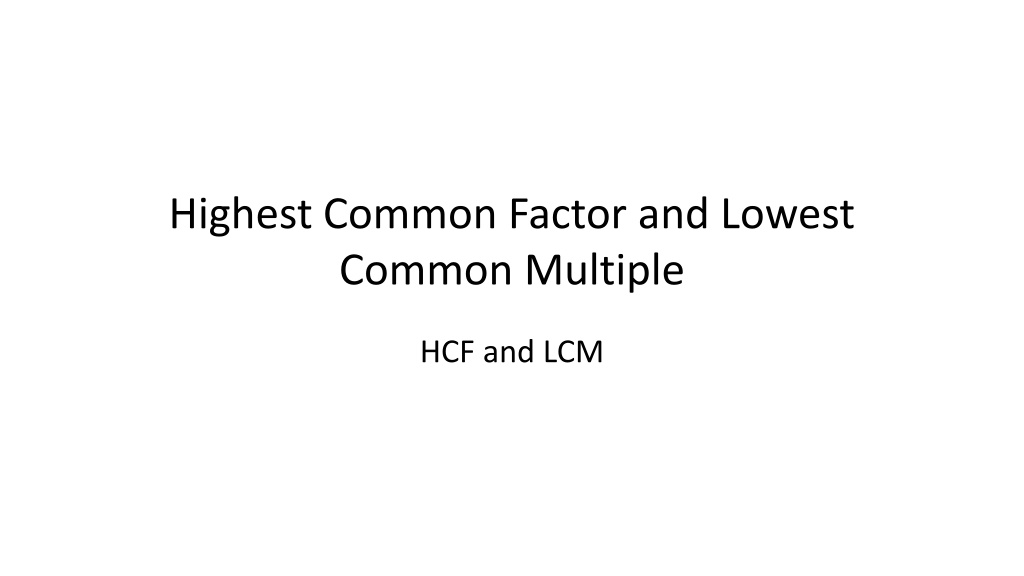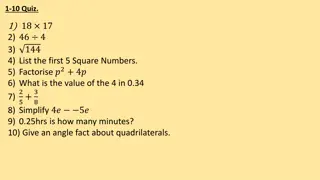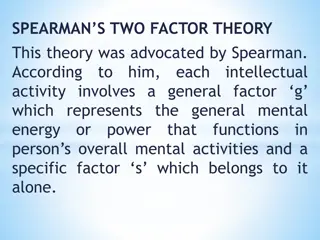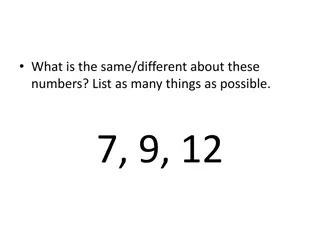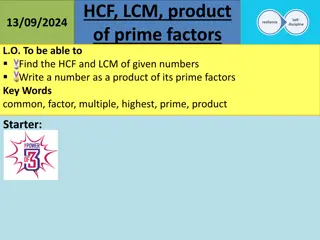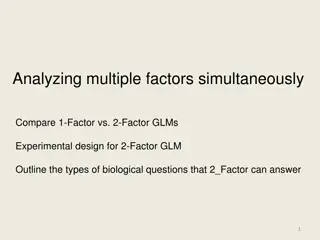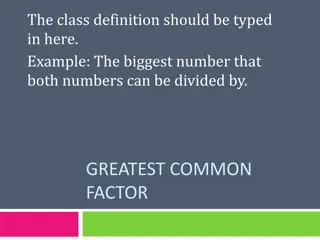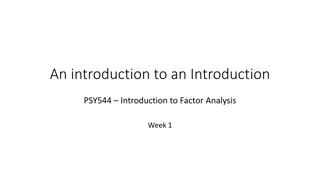HCF, LCM, Prime Numbers, and Factors in Mathematics
Delve into the concepts of Highest Common Factor (HCF), Lowest Common Multiple (LCM), Prime Numbers, and Factors. Learn how to identify prime factors and how they relate to calculating the HCF and LCM of numbers. Explore prime factorization through visual tools like factor trees to enhance your understanding.
Download Presentation

Please find below an Image/Link to download the presentation.
The content on the website is provided AS IS for your information and personal use only. It may not be sold, licensed, or shared on other websites without obtaining consent from the author. Download presentation by click this link. If you encounter any issues during the download, it is possible that the publisher has removed the file from their server.
E N D
Presentation Transcript
Highest Common Factor and Lowest Common Multiple HCF and LCM
Prime Numbers and Prime Factors To study the highest common factor and lowest common multiple of a pair of numbers we first have to understand some of the basics. What is a FACTOR ? A number which divides wholly into another, leaving NO remainder. A number which can only be divided by ITSELF and ONE* What is a PRIME ? What is a PRIME FACTOR ? A number which is PRIME and a FACTOR of the number. To evaluate the HCF and LCM of a pair of numbers means that we have to have a GOOD understanding of prime numbers and prime factors. Before we look at HCF and LCM we will look at these more closely *Although the number 1 fits the definition, it is NOT regarded as a prime number. The first prime number (and the ONLY even prime number) is 2
Factors A number is a factor of another number if it divides wholly into the other number leaving NO remainder or fractional part. 1 2 3 4 5 6 7 8 9 10 11 12 12
Prime Numbers This table contains all of the prime numbers between 1 and 200. You will find it useful to try to memorise at least the primes up to 100.
Prime Factors To factorise a number using prime factors is done by dividing the number (and the result of that division) by the lowest prime, moving to the next suitable prime when the division stops. Sounds weird? Lets take a look at an example, this will clear up the confusion. 36 9 doesn t divide by 2 so we move to the next prime which is 3. We are left with 3, we stop here and list our prime factors.
Prime Factors We usually lay out the numbers as a sort of tree so you will hear the expression prime factor tree in your maths work. Here are a couple of prime factor trees
Hot Spot 1a Q1. Produce a prime factor tree for the number 56 56 56 2 28 2 14 2 7
Hot Spot 1b Q2. Produce a prime factor tree for the number 180 180 2 90 2 45 3 15 3 5
Lowest Common Multiple The LCM is the LOWEST number that is a multiple of two numbers. Example - Find the LCM of the numbers 6 and 8 Common factors are counted only once so the LCM of 6 and 8 is 24
Lowest Common Multiple The LCM is the LOWEST number that is a multiple of two numbers. Example - Find the LCM of the numbers 8 and 12 Common factors are counted only once so the LCM of 8 and 12 is 24
Hot Spot 2 Find the lowest common multiple of each of the following number pairs:
Highest Common Factor The HCF is a little easier to work out. We simply write out the factors of each of the pair and calculate the largest common factor in each list by expanding the common factors: Example: Find the HCF of 26 and 34
Highest Common Factor The HCF is a little easier to work out. We simply write out the factors of each of the pair and calculate the largest common factor in each list by expanding the common factors: Example: Find the HCF of 64 and 244
Highest Common Factor The HCF is a little easier to work out. We simply write out the factors of each of the pair and calculate the largest common factor in each list by expanding the common factors: Example: Find the HCF of 56 and 425 There are NO COMMON FACTORS between 56 and 425. In these cases the HCF is 1 as 1 is a factor of ANY number.
Hot Spot 3 Find the highest common factor of each of the following number pairs:
